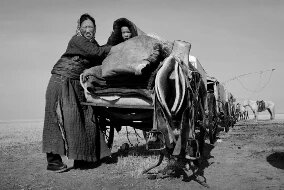
The photographer A Yin portrays Mongolian women in China's autonomous region Inner Mongolia.
Mongolian women traditionally had to fulfill a double role: They built Jurten, learned to ride and graze the cattle, just like the men. Furthermore they had to do the housekeeping. They gave birth to several children without bigger rest periods in between. Therefore, they are seen as „heroines of the steppe“ by outsiders and by many Mongolian men.
Their "Heroines" status has historical causes: to prevent the conquered Mongolian people from uprising, the Manchurian rulers of the Qing dynasty (in 1644-1911) had temples build everywhere. Tibetan Buddhism had a lot of supporters and enjoyed great recognition within Mongolian society. The life as a monk's seemed economically attractive to many men and was connected with high social standing. Thus about one third of the male population decided to join temple communities. As a consequence many women suddenly had to provide for the economic and social welfare of their families on their own.
At times they were made "natal heroines" by the communist government. To protect the region from the Mongolian State and also Russia, Beijing appealed for the child blessing. Duguima (1923-2002) was awarded as "heroic mother", within 28 years she gave birth to 24 children; today 17 of them are still alive. On the move or in the snow – ethnic Mongolian women often deliver their babies simply in between. Besides, they hardly rest before and after the birth.
In spite of their double work load women traditionally take the lowest rank within the society. They are not allowed to take part in religious ceremonies. Some suffer under the violence and alcoholism of their husbands. After the wedding they have to work themselves into the family of their husband as daughter in law. Not until after a few years they are completely accepted as a „certified daughter-in-law“ in the course of a ceremony. Still more and more ethnic Mongolian families focus on a better education, also for their daughters.
------------------
Biography A Yin
A, Yin is a son of the Mongolian steppe and the Chinese town. Born in 1970 under the name Qi Jincai in the east of the autonomous area Inner Mongolia (province in the North of China), he grew up in a melting pot: Nomad's tradition of the ethnic Mongols in China on one, agriculture of the Han Chinese and the starting modernization in the course of the reformist policy after 1979 on the other side.
Quite early A Yin started to record his observations. At first by writing: as a 12-year-old several of his texts were published in omnibus volumes for Mongolian youngsters. With 14 he had to leave school, because his family could not pay the fees any more. As a “mobile trader” for textile goods he travelled around large parts of the about 1.2 millions km2 big Inner Mongolia. Nevertheless, people seldomly asked him for the newest brand clothes but frequently asked him to take a photo of themselves and their families. As a result, A Yin bought his first camera in 1989 and began his way as a „mobile photographer“. Later, as free journalist he also delivered pictures combined with texts to local newspapers.
In 1998 A Yin undertook his first extended photo trip to the northeast border region of Inner Mongolia. The former commercial way of his father, a salt merchant, had inspired him to take this route. He settled down there and gave himself his present name, which in Mongolian has the meaning „to travel far“. Since then he observes and accompanies the life of the nomads between tradition and modern age as a photographer.
Between 1999 and 2003 he has published 26 publications about the nomadic life of the ethnic Mongols in China. In 2007 he received the „All Roads Program“-Award of the US-American "National Geographic" magazine. His photos about the life of the Mongolian nomads were already shown in New York, Los Angeles, Taipeh and Paris. In 2009 and 2010 the China Picture publishing company published four big omnibus volumes of A Yin’s work, among others "Followers of Genghis Khan - Nomadic Mongolians in China" and „Mongolians Schools in China“.
---------------
This might interest you, too:
- Thailand: Women and Community Radio in Thailand
- Thailand: Briefing Report: Women in Thailand
- Thailand: Localizing Feminism: Women’s Voices and Social Activism in Thai Context
- Cambodia: Radioportrait of the cambodian artist Buth Chan Anochea
- Cambodia: Violence against women destroys the present and the future
- China: Law in China is a sleeping Beauty
- India: Giving India’s Women a Voice
- Afghanistan: Be lucky, know the right people
- Afghanistan: How long means never? On International Women’s Day in Kabul, President Karzai commits to women’s rights
- Pakistan: Video: The Swollen Rivers
- Pakistan: Video: "Pakistan: Women’s Cricket Team"
- Pakistan: Video: Two Steps forward
- back to overview Women´s Voices Women´s Choices